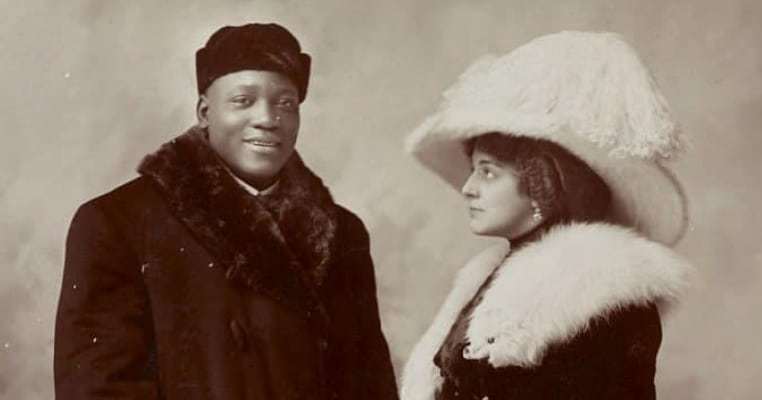Segregation was strictly enforced throughout the Untied States at the onset of the 20th century. Jim Crow laws ruled in southern states and unwritten laws dictated the movement of African Americans in northern and western states. Anyone who stood up to racial injustices quickly found themselves the victim of crimes to which no authority pursued. Terror and violence ruled the nation, particularly in the South. Men and women were hung and left on display to show the power of what would happen if they seemingly disrespected a white person.
For a frail boy in Galveston, Texas, the racial violence was not apparent. He grew up poor with other black and white boys. The son of former slaves, John Arthur “Jack” Johnson as a boy fell in love with boxing. It became his life and in 1898 he made his professional boxing debut. Boxing paid well and soon Johnson was able to live a life that defied his imagined expectations. The boxer frequently visited brothels, married white women, gambled, and raced expensive automobiles. He never apologized for his lifestyle and lived in direct defiance of prescribed social norms in segregated America. Jack Johnson lived unforgivably as a black man.

Round 1: The Gloves
Jack Johnson was the third of nine children and listed his birth date as March 31, 1878. After attending school for five years, Johnson found work on the Galveston docks and then worked his way to Dallas. At 16, he went to Manhattan and exercised race horses. When he was fired for over exercising a horse, he found work as a janitor in a boxing gym. Johnson fell in love with the sport and began learning whenever he could. He returned to Galveston and was arrested for playing in an illegal craps game. When he and his cohort were released, the two men fought each other in front of a large crowd. This post-jailhouse fight was the beginning of Johnson’s extensive boxing career.
Johnson turned professional 1898 and fought many famous African American boxers. When police arrested Johnson and Joe Choynski for illegally fighting on February 25, 1901, the men agreed to fight in the jailhouse each day in exchanged for spending the night in their own homes. Large crowds visited the jail to see the men fight behind bars. Later in life, Johnson credited Choynski with many of the skills that he developed during those jailhouse bouts.
Jack Johnson continued to box against numerous African American boxers. A hallmark of his boxing was his ability to trash talk his opponent in the ring as well as the spectators outside of the ring. His skill as a boxer drew people to watch him. Soon he was the Colored Heavyweight World Champion and he was amassing a fortune. Jack Johnson was never shy about displaying his wealth nor was he shy about frequenting brothels and marrying white women. Many viewed his lifestyle as deplorable and full of debauchery.

Johnson’s manager, George Little, took him to the exclusive Everleigh Club in Chicago’s Levee District on March 13, 1909. Little had long been a brothel owner and “levee czar” who collected protection payments that he passed along to the ward boss. At 6 foot 2 inches and 200 pounds, Johnson was a formidable figure in the club’s doorway. His $1500 diamond ring glistened in the candlelight and the girls were smitten with his charm. When Belle Schreiber was caught with Johnson the next day touring the streets of Chicago against the wishes of her employers, she was fired. For a few months, Belle was Johnson’s favorite girl until he met another woman. Perhaps feeling guilty, he gave Belle money so that she could open her own brothel.
Jack Johnson continued to live in an extravagant and controversial manner. As a boxer, Johnson continued to win bout after bout against other black boxers. It was time for him to fight the undefeated Heavyweight World Champion, the retired Jim Jeffries. When Jack Johnson and Jim Jeffries faced off in Reno, Nevada on July 4, 1910, throngs of people could hardly contain their excitement. In one corner was the former white boxing champ that represented the ideals of racial superiority and in the other corner was a black man that represented the hope that African Americans would overcome a segregated society.

